Walker J. Facies models, Canada, 1992
Подождите немного. Документ загружается.


CONIGLIO. DIX
moving downslope.
Escarpments along some erosional
slopes or bypass margins attest to
removal of significant volumes of
material. The shelf edge along the
Mesozoic carbonate platform of east-
ern North America, for example, was
cut back in places up to 30 km (Jansa,
1981). Erosional slopes such as the
Blake, Bahama and west Florida es-
carpments may have retreated land-
ward as much as 5 to 15 km (Fig. 1
;
Mullins
et a/.,
1986). These steep
slopes are due to faulting, erosion by
contour currents, carbonate dissolu-
tion by corrosive bottom waters and
acidic brine seeps, and mechanical
weakening caused by organisms
which bore into, dissolve, or disaggre-
gate the
rockface (Paull
eta/.,
1990;
Twichell
et a/.,
1990). Escarpments
can also develop from sliding and
gravity current erosion initiated by sed-
iment overload.
Erosional slopes have the lowest
preservation potential and their exis-
tence must be inferred from abundant
slope-derived material that is preserved
in more distal facies. The more complete
record afforded by depositional slopes
provides practically all of the information
obtained on ancient carbonate slope
successions and much of what is known
from modem carbonate slopes.
Slope morphology
Modern carbonate slopes are generally
steeper than their terrigenous counter-
parts (Table 1). Modern carbonate
slopes tend toward concavity with the
angle of the upper slope increasing
with slope height. The slope north of
Little Bahama Bank, for example, is
steepest near the top
(14"
in 200-900
m water depth) and more gentle below
(1-2"; Fig. 5a). Carbonate slopes adja-
cent to open platforms with relatively
deep margins ("distally-steepened
ramp"
sensu
Read, 1985) resemble
siliciclastic slopes in profile
(e.g., west
Florida, Banco de Campeche; Fig. 1).
Steepening of a carbonate slope, par-
ticularly the upper slope, can result from
1) organic binding and framework
building by reef-forming organisms, 2)
submarine cementation, and
3) shallow
subsurface lithification. Early lithification
may act to delay large-scale failure.
Other factors that can control slope gra-
dient include
1)
inheritance of predepo-
sitional paleoplatform margin morph-
SLOPE
GEOMETRY
SLOPE
MORPHOLOGY
DEPOSITIONAL SLOPE
4,'.
MIGRATION OF
BYPASS SLOPE
DEPOCENTER
OUTCROPS, PATCHY PELAGIC
SEDIMENT, HARDGROUNDS
Figure
3
Relationship between
slope
geometry, morphology, sediment budget, and
propensity for
seafloor lithification based on Bahamas and ancient platforms. Modified from
Schlager and Camber (1986).
DISTANCE FROM PLATFORM MARGIN
(km)
CHANNEL
DEPOSITIONAL
------
TONGUE
EXUMA
\,,-,,
EROSIONAL
Figure
4 Bathymetric profiles of various Bahamian platform slopes and relation to deposi-
tional regime. Modified from Schlager and
Ginsburg (1981).
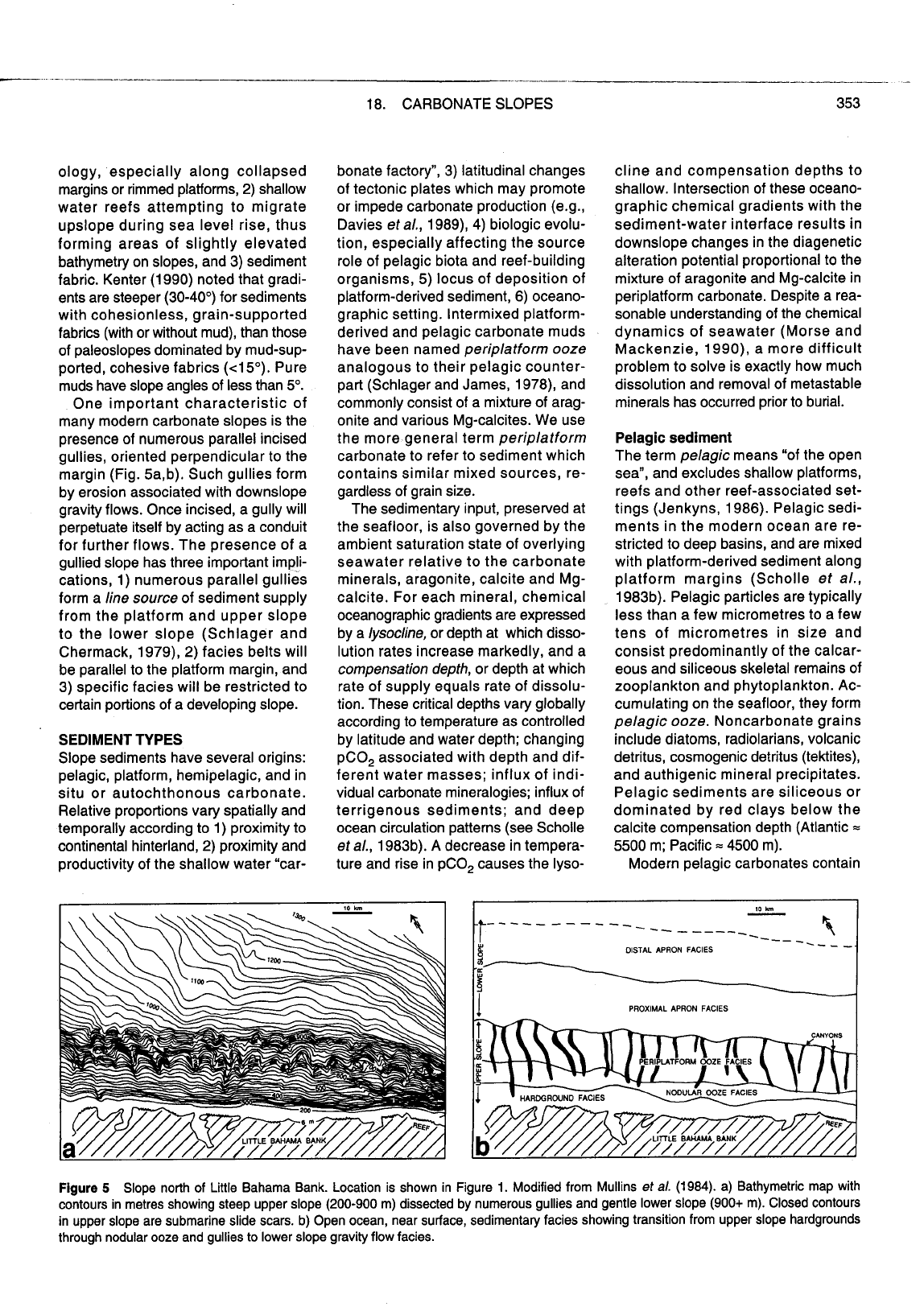
--
-
-
18. CARBONATE SLOPES 353
ology, especially along collapsed
margins or rimmed platforms, 2) shallow
water reefs attempting to migrate
upslope during sea level rise, thus
forming areas of slightly elevated
bathymetry on slopes, and 3) sediment
fabric. Kenter (1 990) noted that gradi-
ents are steeper
(30-40") for sediments
with cohesionless, grain-supported
fabrics (with or without mud), than those
of paleoslopes dominated by mud-sup-
ported, cohesive fabrics
(45"). Pure
muds have slope angles of less than 5".
One important characteristic of
many modern carbonate slopes is the
presence of numerous parallel incised
gullies, oriented perpendicular to the
margin (Fig.
5a,b). Such gullies form
by erosion associated with downslope
gravity flows. Once incised, a gully will
perpetuate itself by acting as a conduit
for further flows. The presence of a
gullied slope has three important impli-
cations,
1) numerous parallel gullies
form a
line source
of sediment supply
from the platform and upper slope
to the lower slope (Schlager and
Chermack,
1979),
2)
facies belts will
be parallel to the platform margin, and
3) specific facies will be restricted to
certain portions of a developing slope.
SEDIMENT TYPES
Slope sediments have several origins:
pelagic, platform, hemipelagic, and in
situ or autochthonous carbonate.
Relative proportions vary spatially and
temporally according to
1)
proximity to
continental hinterland, 2) proximity and
productivity of the shallow water "car-
bonate factory",
3)
latitudinal changes
of tectonic plates which may promote
or impede carbonate production
(e.g.,
Davies
et al.,
1989), 4) biologic evolu-
tion, especially affecting the source
role of pelagic biota and reef-building
organisms,
5)
locus of deposition of
platform-derived sediment,
6)
oceano-
graphic setting. Intermixed
platform-
derived and pelagic carbonate muds
have been named
periplatform ooze
analogous to their pelagic counter-
part (Schlager and James,
1978), and
commonly consist of a mixture of arag-
onite and various Mg-calcites. We use
the more general term
periplatform
carbonate to refer to sediment which
contains similar mixed sources, re-
gardless of grain size.
The sedimentary input, preserved at
the seafloor, is also governed by the
ambient saturation state of overlying
seawater relative to the carbonate
minerals, aragonite, calcite and
Mg-
calcite. For each mineral, chemical
oceanographic gradients are expressed
by a
lysocline,
or depth at which disso-
lution rates increase markedly, and a
compensation depth,
or depth at which
rate of supply equals rate of dissolu-
tion. These critical depths vary globally
according to temperature as controlled
by latitude and water depth; changing
pCO, associated with depth and dif-
ferent water masses; influx of indi-
vidual carbonate mineralogies; influx of
terrigenous sediments; and deep
ocean circulation patterns (see Scholle
et al.,
1983b). A decrease in tempera-
ture and rise in
pCO, causes the lyso-
cline and compensation depths to
shallow, Intersection of these oceano-
graphic chemical gradients with the
sediment-water interface results in
downslope changes in the diagenetic
alteration potential proportional to the
mixture of aragonite and Mg-calcite in
periplatform carbonate. Despite a rea-
sonable understanding of the chemical
dynamics of seawater (Morse and
Mackenzie,
1990), a more difficult
problem to solve is exactly how much
dissolution and removal of metastable
minerals has occurred prior to burial.
Pelagic sediment
The term
pelagic
means "of the open
sea", and excludes shallow platforms,
reefs and other reef-associated set-
tings (Jenkyns, 1986). Pelagic sedi-
ments in the modern ocean are re-
stricted to deep basins, and are mixed
with platform-derived sediment along
platform margins (Scholle
et al.,
1983b). Pelagic particles are typically
less than a few micrometres to
a
few
tens of micrometres in size and
consist predominantly of the calcar-
eous and siliceous skeletal remains of
zooplankton and phytoplankton. Ac-
cumulating on the seafloor, they form
pelagic ooze.
Noncarbonate grains
include diatoms, radiolarians, volcanic
detritus, cosmogenic detritus (tektites),
and authigenic mineral precipitates.
Pelagic sediments are siliceous or
dominated by red clays below the
calcite compensation depth (Atlantic
=
5500 m; Pacific
=
4500
m).
Modern pelagic carbonates contain
---------
-----__---
-----._
_
_
DISTAL APRON FAClES
PROXIMAL APRON FACIES
Figure
5
Slope north of Little Bahama Bank. Location is shown in Figure 1. Modified from Mullins
et
a/.
(1984). a) Bathymetric map with
contours in metres showing steep upper slope (200-900 m) dissected
by
numerous gullies and gentle lower slope (900+ m). Closed contours
in upper slope are submarine slide scars.
b)
Open ocean, near surface, sedimentary facies showing transition from upper slope hardgrounds
through nodular ooze and gullies to lower slope gravity flow facies.
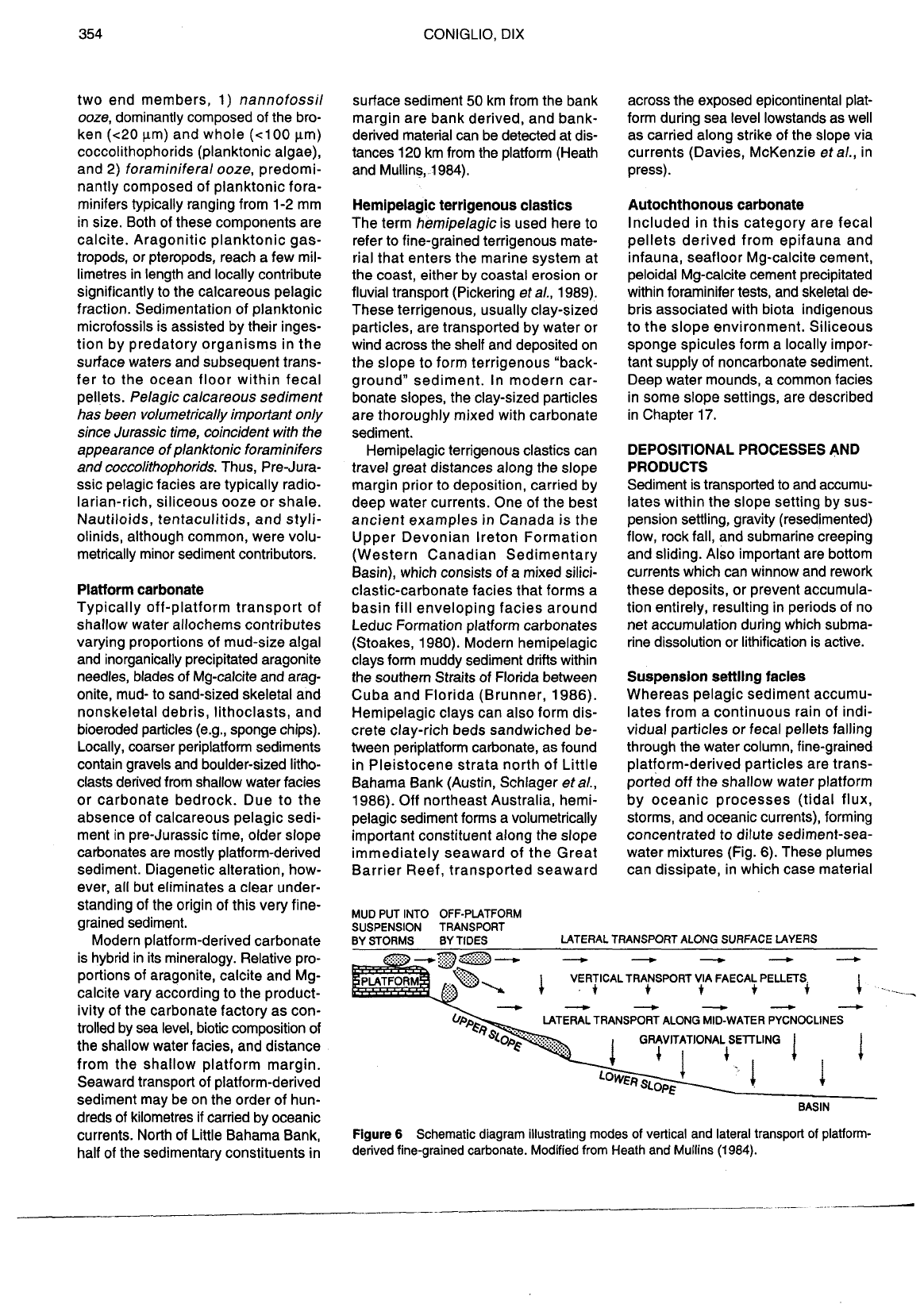
354 CONIGLIO. DIX
two end members, 1) nannofossil
ooze, dominantly composed of the bro-
ken
(c20 pm) and whole (<I00 pm)
coccolithophorids (planktonic algae),
and 2) foraminifera1 ooze, predomi-
nantly composed of planktonic fora-
minifers typically ranging from 1-2 mm
in size. Both of these components are
calcite. Aragonitic planktonic gas-
tropods, or pteropods, reach a few mil-
limetres in length and locally contribute
significantly to the calcareous pelagic
fraction. Sedimentation of planktonic
microfossils is assisted by their inges-
tion by predatory organisms in the
surface waters and subsequent trans-
fer to the ocean floor within fecal
pellets. Pelagic calcareous sediment
has been volumetrically important only
since Jurassic time, coincident with the
appearance of planktonic foraminifers
and
coccolithophorids. Thus, Pre-Jura-
ssic pelagic facies are typically radio-
larian-rich, siliceous ooze or shale.
Nautiloids, tentaculitids, and
styli-
olinids, although common, were volu-
metrically minor sediment contributors.
Platform carbonate
Typically off-platform transport of
shallow water
allochems contributes
varying proportions of mud-size algal
and inorganically precipitated aragonite
needles, blades of Mg-calcite and arag-
onite,
mud- to sand-sized skeletal and
nonskeletal debris, lithoclasts, and
bioeroded particles
(e.g., sponge chips).
Locally, coarser periplatform sediments
contain gravels and boulder-sized
litho-
clasts derived from shallow water facies
or carbonate bedrock. Due to the
absence of calcareous pelagic sedi-
ment in pre-Jurassic time, older slope
carbonates are mostly platform-derived
sediment. Diagenetic alteration, how-
ever, all but eliminates a clear under-
standing of the origin of this very
fine-
grained sediment.
Modern platform-derived carbonate
is hybrid in its mineralogy. Relative pro-
portions of aragonite, calcite and
Mg-
calcite vary according to the product-
ivity of the carbonate factory as con-
trolled by sea level, biotic composition of
the shallow water facies, and distance
from the shallow platform margin.
Seaward transport of platform-derived
sediment may be on the order of hun-
dreds of kilometres if carried by oceanic
surface sediment 50
km from the bank
margin are bank derived, and
bank-
derived material can be detected at dis-
tances
120
km from the platform (Heath
and
Mullins, 1984).
Hemipelagic terrigenous clastics
The term hemipelagic is used here to
refer to fine-grained terrigenous mate-
rial that enters the marine system at
the coast, either by coastal erosion or
fluvial transport (Pickering etal., 1989).
These terrigenous, usually clay-sized
particles, are transported by water or
wind across the shelf and deposited on
the slope to form terrigenous "back-
ground" sediment. In modern car-
bonate slopes, the clay-sized particles
are thoroughly mixed with carbonate
sediment.
Hemipelagic terrigenous
clastics can
travel great distances along the slope
margin prior to deposition, carried by
deep water currents. One of the best
ancient examples in Canada is the
Upper Devonian lreton Formation
(Western Canadian Sedimentary
Basin), which consists of a mixed
silici-
clastic-carbonate facies that forms a
basin fill enveloping facies around
Leduc Formation platform carbonates
(Stoakes, 1980). Modern hemipelagic
clays form muddy sediment drifts within
the southern Straits of Florida between
Cuba and Florida (Brunner, 1986).
Hemipelagic clays can also form dis-
crete clay-rich beds sandwiched be-
tween periplatform carbonate, as found
in Pleistocene strata north of Little
Bahama Bank (Austin, Schlager etal.,
1986). Off northeast Australia,
hemi-
pelagic sediment forms a volumetrically
important constituent along the slope
immediately seaward of the Great
Barrier Reef, transported seaward
across the exposed epicontinental plat-
form during sea level lowstands as well
as carried along strike of the slope via
currents (Davies,
McKenzie etal., in
press).
Autochthonous carbonate
Included in this category are fecal
pellets derived from epifauna and
infauna, seafloor Mg-calcite cement,
peloidal Mg-calcite cement precipitated
within foraminifer tests, and skeletal de-
bris associated with biota indigenous
to the slope environment. Siliceous
sponge spicules form a locally impor-
tant supply of noncarbonate sediment.
Deep water mounds, a common facies
in some slope settings, are described
in Chapter
17.
DEPOSITIONAL PROCESSES AND
PRODUCTS
Sediment is transported to and accumu-
lates within the slope setting by sus-
pension settling, gravity (resedimented)
flow, rock fall, and submarine creeping
and sliding. Also important are bottom
currents which can winnow and rework
these deposits, or prevent accumula-
tion entirely, resulting in periods of no
net accumulation during which subma-
rine dissolution or lithification is active.
Suspension settllng facies
Whereas pelagic sediment accumu-
lates from a continuous rain of indi-
vidual particles or fecal pellets falling
through the water column, fine-grained
platform-derived particles are trans-
ported off the shallow water platform
by oceanic processes (tidal flux,
storms, and oceanic currents), forming
concentrated to dilute sediment-sea-
water mixtures (Fig. 6). These plumes
can dissipate, in which case material
MUD
PUT
INTO
OFF-PLATFORM
SUSPENSION
TRANSPORT
BY
STORMS
BY
TIDES
LATERAL
TRANSPORT
ALONG
SURFACE
LAYERS
------t
---t
-
--t
-.-c
1
VERTICAL
TRANSPORT
VIA
FAECAL
PELLETS
t
t
t
t
t
i
-...
LATERAL
TRANSPORT
ALONG
MID-WATER
PYCNOCLINES
GRAVITATIONAL SEllLlNG
BASIN
currents. North of Little
~ahama Bank,
Figure
6 Schematic diagram illustrating modes of vertical and lateral transport of platform-
half of the sedimentary constituents in
derived fine-grained carbonate. Modified from Heath and Mullins
(1984).
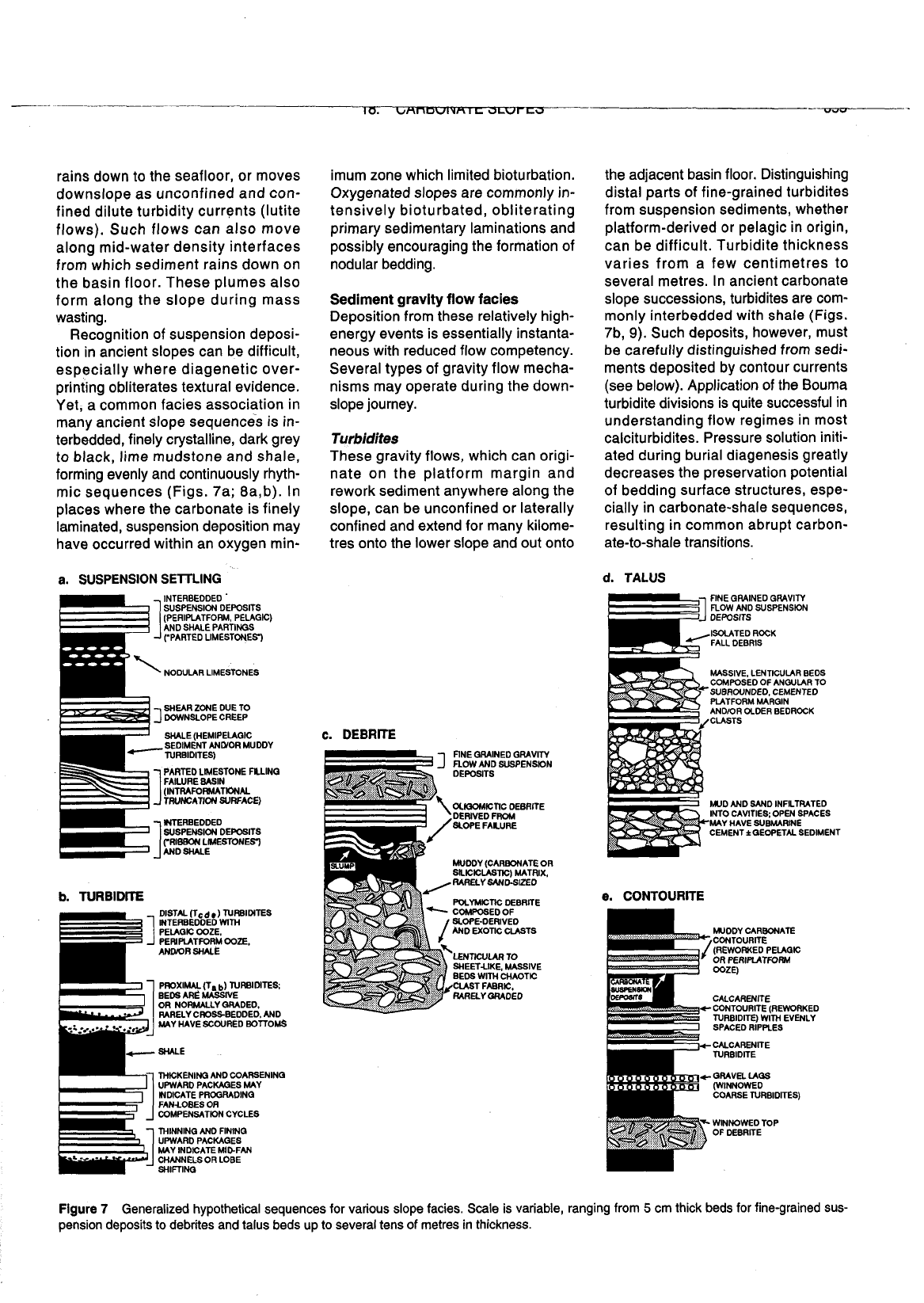
rains down to the seafloor, or moves
downslope as unconfined and con-
fined dilute turbidity currents (lutite
flows). Such flows can also move
along mid-water density interfaces
from which sediment rains down on
the basin floor. These plumes also
form along the slope during mass
wasting.
Recognition of suspension deposi-
tion in ancient slopes can be difficult,
especially where diagenetic over-
printing obliterates textural evidence.
Yet, a common facies association in
many ancient slope sequences is
in-
terbedded, finely crystalline, dark grey
to black, lime
mudstone and shale,
forming evenly and continuously rhyth-
mic sequences (Figs. 7a;
8a,b). In
places where the carbonate is finely
laminated, suspension deposition may
have occurred within an oxygen
min-
a.
SUSPENSION SEllLING
INTERBEDDED
'
SUSPENSION DEPOSITS
IPERIPLATFORM. PELAGIC\
h~
SHALE PARTINGS
'
('PARTED LIMESTONES)
NODULAR LIMESTONES
WEAR ZONE DUE TO
DOWNSLOPE CREEP
WE (HEMIPELAGIC
-SEDIMENT ANLYOR MUDDY
NRBIDITES)
I
PARTED LIMESTONE RLINQ
FAILURE BASIN
(INTRAFOIWATIONAL
TRVNCATKWJ SURFACE)
I
FlTERBEDDED
SUSPENSION DEFOSITS
CRIBEON LIMESTONES)
AND
SME
DISTAL (Tc,j.) NRBIDIES
INTERBEDDED WITH
PELAGIC OOZE.
PERIPUTFORM OOZE.
ANDlOR SHALE
PROXIMAL (Tlb) NRBIDITES;
BEC6
ARe
UASSNE
1
COMPENSATION CYCLES
I]
UPWARD THINNINQ PACKAGES
AND
FINING
i-
-
1
MAY INDICATE MIDFAN
CHANNELS OR LOBE
SHIFTING
imum zone which limited bioturbation.
Oxygenated slopes are commonly in-
tensively bioturbated, obliterating
primary sedimentary laminations and
possibly encouraging the formation of
nodular bedding.
Sediment gravity
flow
facies
Deposition from these relatively high-
energy events is essentially instanta-
neous with reduced flow competency.
Several types of gravity flow mecha-
nisms may operate during the
down-
slope journey.
Turbidites
These gravity flows, which can origi-
nate on the platform margin and
rework sediment anywhere along the
slope, can be unconfined or laterally
confined and extend for many
kilome-
tres onto the lower slope and out onto
flNE GRAINED GRAVITY
aCwcnc
DEBRITE
DERIVED FROM
BLOPE FAILURE
MIDDY (CARBONATE OR
SLICICLASTK:) MATRIX.
POLYMICTlC DEBRITE
-
COMFOSED OF
&WE-DERIVED
AND EXOTIC WTS
LENTICULAR TO
WEETUKE, MASSIVE
BEDS
WN CHAOTK:
RARELY WDED
the adjacent basin floor. Distinguishing
distal parts of fine-grained turbidites
from suspension sediments, whether
platform-derived or pelagic in origin,
can be difficult. Turbidite thickness
varies from a few centimetres to
several metres. In ancient carbonate
slope successions, turbidites are com-
monly interbedded with shale
(Figs.
7b,
9).
Such deposits, however, must
be carefully distinguished from sedi-
ments deposited by contour currents
(see below). Application of the Bouma
turbidite divisions is quite successful in
understanding flow regimes in most
calciturbidites. Pressure solution initi-
ated during burial diagenesis greatly
decreases the preservation potential
of bedding surface structures, espe-
cially in carbonate-shale sequences,
resulting in common abrupt carbon-
ate-to-shale transitions.
d.
TALUS
FINE GRAINED GRAVITY
now
AND
SUSPENSDN
DEPOSITS
MASSIVE. LENTICULAR BEDS
COMPOSED OF ANGULAR TO
'SUBROUNDED. CEMENTED
PLATFORM MARGIN
AND/OR OLDER BEDROCK
rCLASTS
e.
CONTOURKE
MUDDY CARBONATE
CONTOURITE
(REWOMED PELAGIC
OR PERIPLATFORM
OOZE)
CNCARENITE
r
CONTOURITE (REWORKED
NRBIDITE) WITH EVENLY
SPACED RIPPLES
CALCARENITE
NRBlDlTE
r
GRAVEL LA09
(WINNOWED
COARSE NRBIDITES)
WINNOWED TOP
OF
DEBRITE
Figure
7
Generalized hypothetical sequences for various slope facies. Scale is variable, ranging from 5 cm thick beds for fine-grained sus-
pension deposits to
debrites and talus beds up to several tens of metres in thickness.
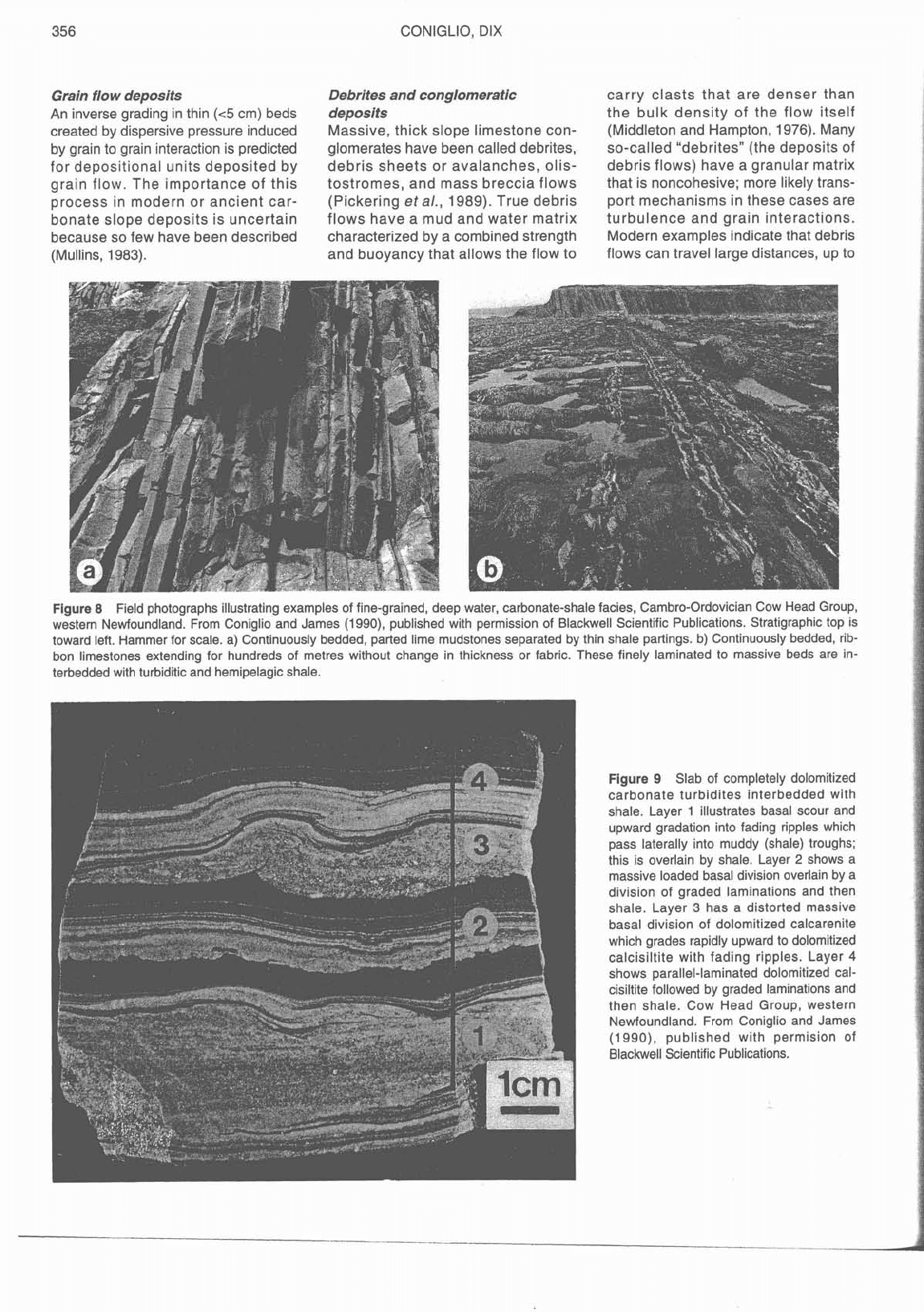
356 CONIGLIO,
DIX
Grain flow deposits
An inverse grading in thin
(c5
cm) beds
created by dispersive pressure induced
by grain to grain interaction is predicted
for depositional units deposited by
grain flow. The importance of this
process in modern or ancient car-
bonate slope deposits is uncertain
because so few have been described
(Mullins, 1983).
Debrites and conglomeratic
deposits
Massive, thick slope limestone con-
glomerates have been called debrites,
debris sheets or avalanches,
olis-
tostromes, and mass breccia flows
(Pickering
eta/.,
1989). True debris
flows have a mud and water matrix
characterized by a combined strength
and buoyancy that allows the flow to
carry clasts that are denser than
the bulk density of the flow itself
(Middleton and Hampton, 1976). Many
so-called "debrites" (the deposits of
debris flows) have a granular matrix
that is noncohesive; more likely trans-
port mechanisms in these cases are
turbulence and grain interactions.
Modern examples indicate that debris
flows can travel large distances, up to
Figure
8
Field photographs illustrating examples of fine-grained, deep water, carbonate-shale facies, Cambro-Ordovician Cow Head Group,
western Newfoundland. From Coniglio and James
(1990), published with permission of Blackwell Scientific Publications. Stratigraphic top is
toward left. Hammer for scale. a) Continuously bedded, parted lime mudstones separated by thin shale partings. b) Continuously bedded, rib-
bon limestones extending for hundreds of metres without change in thickness or fabric. These finely laminated to massive beds are in-
terbedded with turbiditic and hemipelagic shale.
Figure
9
Slab of completely dolomitized
carbonate turbidites interbedded with
shale. Layer 1 illustrates basal scour and
upward gradation into fading ripples which
pass laterally into muddy (shale) troughs;
this is overlain by shale. Layer
2
shows a
massive loaded basal division overlain by a
division of graded laminations and then
shale. Layer
3
has a distorted massive
basal division of dolomitized calcarenite
which grades rapidly upward to dolomitized
calcisiltite with fading ripples. Layer
4
shows parallel-laminated dolomitized cal-
cisiltite followed by graded laminations and
then shale. Cow Head Group, western
Newfoundland. From Coniglio and James
(1990), published with permision of
Blackwell Scientific Publications.
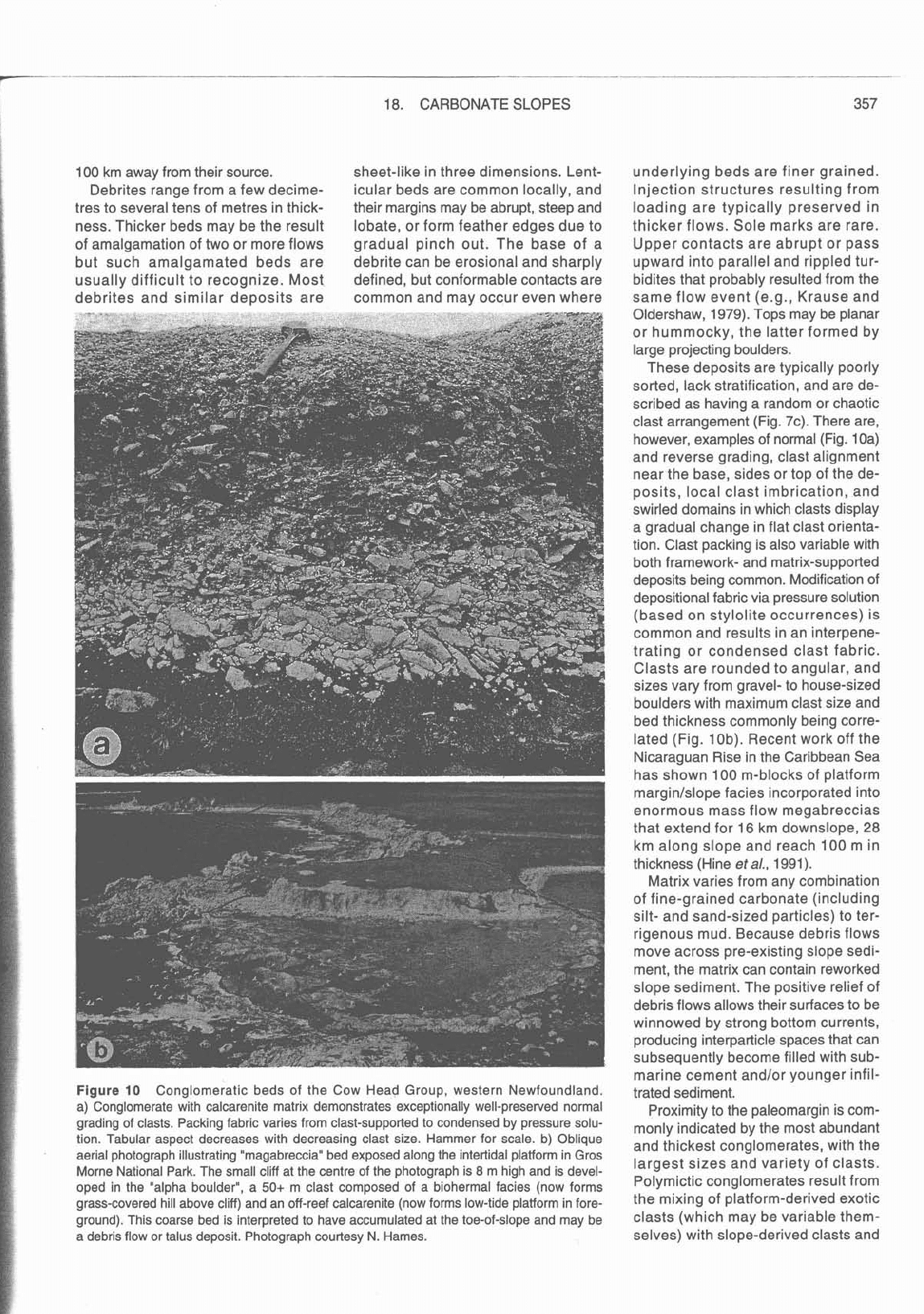
r
18. CARBONATE SLOPES
100 km away from their source.
Debrites range from a few decime-
tres to several tens of metres in thick-
ness. Thicker beds may be the result
of amalgamation of two or more flows
but such amalgamated beds are
usually difficult to recognize. Most
debrites and similar de~osits are
sheet-like in three dimensions. Lent-
icular beds are common locally, and
their margins may be abrupt, steep and
lobate, or form feather edges due to
gradual pinch out. The base of a
debrite can be erosional and sharply
defined, but conformable contacts are
common and mav occur even where
Figure
10
Conglomeratic beds of the Cow Head Group, western Newfoundland.
a) Conglomerate with calcarenite matrix demonstrates exceptionally well-preserved normal
grading of clasts. Packing fabric varies from clast-supported to condensed by pressure solu-
tion. Tabular aspect decreases with decreasing clast size. Hammer for scale. b) Oblique
aerial photograph illustrating "magabreccia" bed exposed along the intertidal platform in Gros
Morne National Park. The small cliff at the centre of the photograph is
8
m high and is devel-
oped in the "alpha boulder", a
50+
m clast composed of a biohermal facies (now forms
grass-covered hill above cliff) and an off-reef calcarenite (now forms low-tide platform in fore-
ground). This coarse bed is interpreted to have accumulated at the toe-of-slope and may be
a debris flow or talus deposit. Photograph courtesy
N.
Hames.
underlying beds are finer grained.
Injection structures resulting from
loading are typically preserved in
thicker flows. Sole marks are rare.
Upper contacts are abrupt or pass
upward into parallel and rippled
tur-
bidites that probably resulted from the
same flow event
(e.~., Krause and
Oldershaw, 1979).
TO~S
may be planar
or hummocky, the latter formed by
large projecting boulders.
These deposits are typically poorly
sorted, lack stratification, and are de-
scribed as having a random or chaotic
clast arrangement (Fig.
7c). There are,
however, examples of normal (Fig.
10a)
and reverse grading, clast alignment
near the base, sides or top of the de-
posits, local clast imbrication, and
swirled domains in which clasts display
a gradual change in flat clast orienta-
tion. Clast packing is also variable with
both framework- and matrix-supported
deposits being common. Modification of
depositional fabric via pressure solution
(based on stylolite occurrences) is
common and results in an interpene-
trating or condensed clast fabric.
Clasts are rounded to angular, and
sizes vary from gravel- to house-sized
boulders with maximum clast size and
bed thickness commonly being corre-
lated (Fig.
lob). Recent work off the
Nicaraguan Rise in the Caribbean Sea
has shown 100 m-blocks of platform
marginlslope facies incorporated into
enormous mass flow megabreccias
that extend for 16 km downslope, 28
km along slope and reach 100 m in
thickness (Hine
etal.,
1991).
Matrix varies from any combination
of fine-grained carbonate (including
silt- and sand-sized particles) to
ter-
rigenous mud. Because debris flows
move across pre-existing slope sedi-
ment, the matrix can contain reworked
slope sediment. The positive relief of
debris flows allows their surfaces to be
winnowed by strong bottom currents,
producing interparticle spaces that can
subsequently become filled with sub-
marine cement
and/or younger infil-
trated sediment.
Proximity to the paleomargin is com-
monly indicated by the most abundant
and thickest conglomerates, with the
largest sizes and variety of clasts.
Polymictic conglomerates result from
the mixing of platform-derived exotic
clasts (which may be variable them-
selves) with slope-derived clasts and
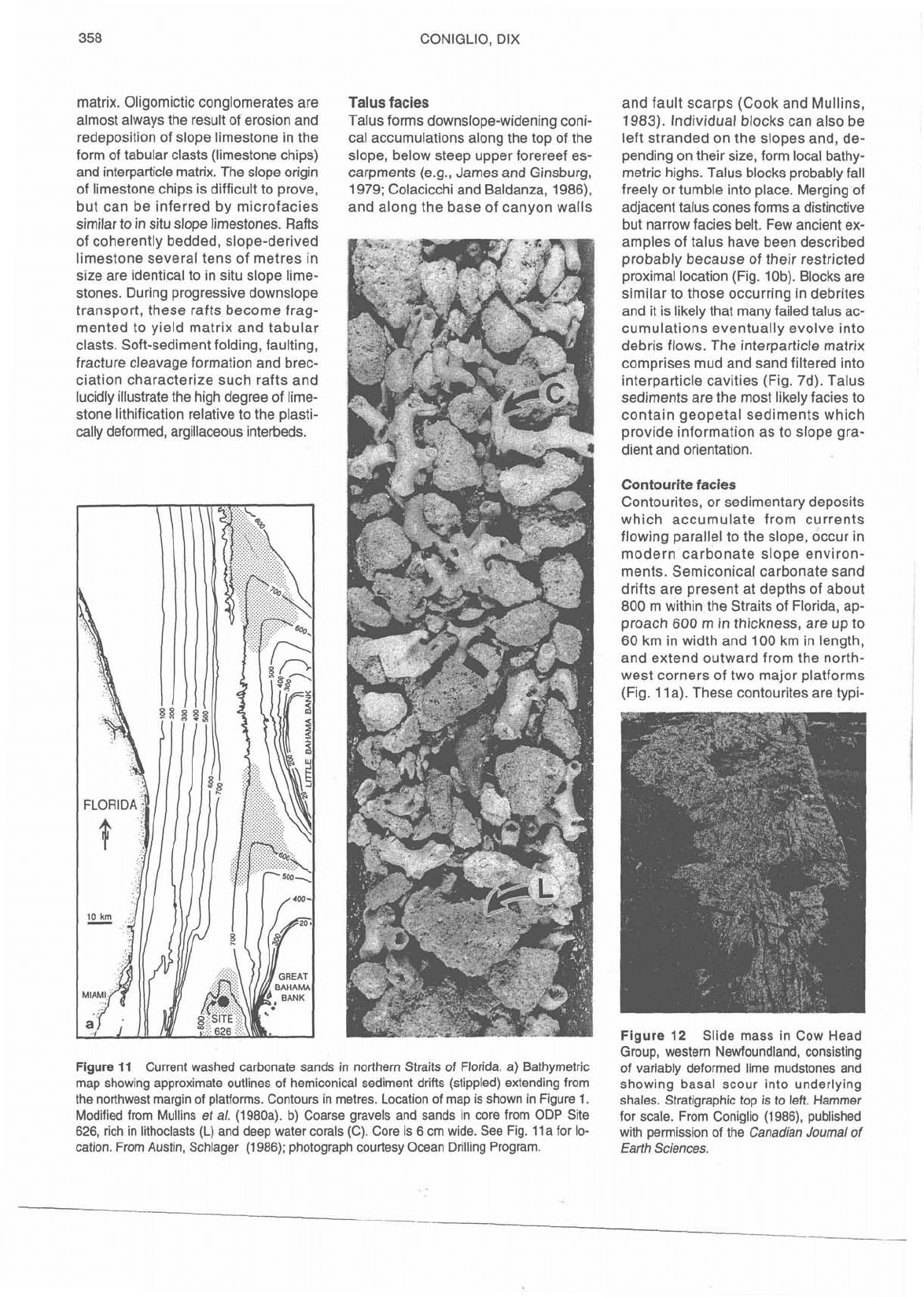
CONIGLIO, DIX
matrix.
Oligomictic conglomerates are
almost always the result of erosion and
redeposition of slope limestone in the
form of tabular clasts (limestone chips)
and interparticle matrix. The slope origin
of limestone chips is difficult to prove,
but can be inferred by microfacies
similar to in situ
slo~e limestones. Rafts
of coherently bedded, slope-derived
limestone several tens of metres in
size are identical to in situ slope lime-
stones. During progressive downslope
transport, these rafts become frag-
mented to yield matrix and tabular
clasts. Soft-sediment folding, faulting,
fracture cleavage formation and
brec-
ciation characterize such rafts and
lucidly illustrate the high degree of lime-
stone
lithification relative to the plasti-
cally deformed, argillaceous interbeds.
Talus facies
and fault scarps (Cook and Mullins,
Talus forms downslope-widening coni- 1983). Individual blocks can also be
cal accumulations along the top of the left stranded on the slopes and, de-
slope, below steep upper
forereef es-
pending on their size, form local
bathy-
carpments (e.g., James and Ginsburg, metric highs. Talus blocks probably fall
1979; Colacicchi and
Baldanza, 1986),
freely or tumble into place. Merging of
and along the base of canyon walls
adjacent talus cones forms a distinctive
but narrow facies belt. Few ancient ex-
amples of talus have been described
probably because of their restricted
proximal location (Fig.
lob). Blocks are
similar to those occurring in
debrites
and it is likely that many failed talus ac-
cumulations eventually evolve into
debris flows. The interparticle matrix
comprises mud and sand filtered into
interparticle cavities (Fig. 7d). Talus
sediments are the most likely facies to
contain geopetal sediments which
provide information as to slope gra-
dient and orientation.
Contourite
facies
Contourites, or sedimentary deposits
which accumulate from currents
flowing parallel to the slope, occur in
modern carbonate slope environ-
ments. Semiconical carbonate sand
drifts are present at depths of about
800 m within the Straits of Florida, ap-
proach 600
rn
in thickness, are up to
60
km in width and 100 km in length,
and extend outward from the north-
west corners of two major platforms
(Fig.
11 a). These contourites are typi-
Figure
12
Slide mass in Cow Head
Group, western Newfoundland, consisting
Figure
11
Current washed carbonate sands in northern Straits of Florida. a) Bathymetric
of variably deformed lime mudstones and
map showing approximate outlines of hemiconical sediment drifts (stippled) extending from
showing basal scour into
under1 ying
the northwest margin of platforms. Contours in metres. Location
of
map is shown in Figure
1.
shales. Stratigraphic top is to left. Hammer
Modified from
Mullins
et
a/.
(1980a). b) Coarse gravels and sands in core from ODP Site
for scale. From
Coniglio (1986), published
626, rich in
lithoclasts
(L)
and deep water corals
(C).
Core is 6 cm wide. See Fig. 11
a
for lo-
with permission of the
Canadian
Journal
of
cation. From Austin, Schlager (1986); photograph courtesy Ocean Drilling Program.
Earth
Sciences.
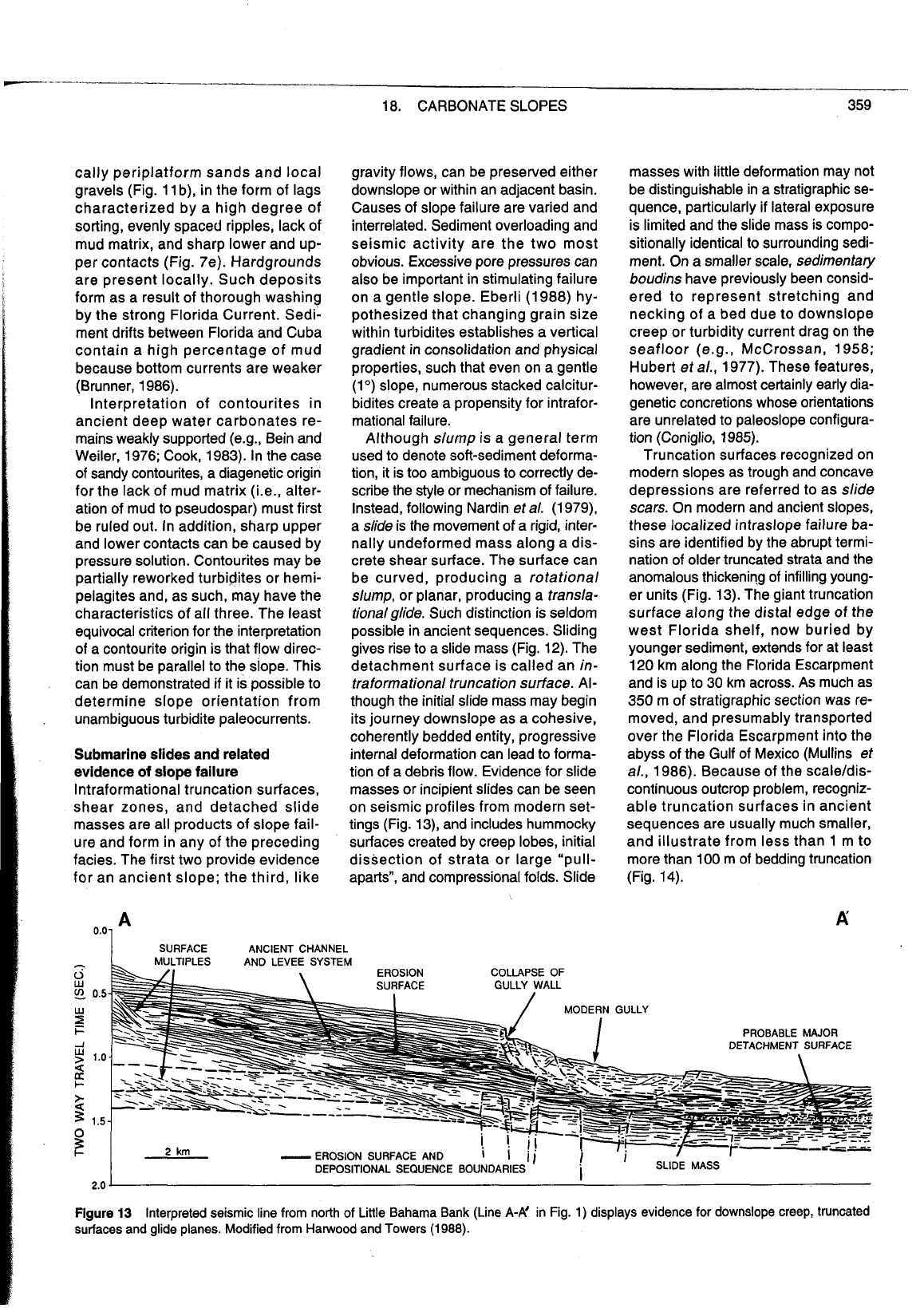
7--
--
-
18. CARBONATE SLOPES 359
cally periplatform sands and local
gravels (Fig.
11 b), in the form of lags
characterized by a high degree of
sorting, evenly spaced ripples, lack of
mud matrix, and sharp lower and up-
per contacts (Fig. 7e). Hardgrounds
are present locally. Such deposits
form as a result of thorough washing
by the strong Florida Current. Sedi-
ment drifts between Florida and Cuba
contain a high percentage of mud
because bottom currents are weaker
(Brunner, 1986).
Interpretation of contourites in
ancient deep water carbonates re-
mains weakly supported
(e.g., Bein and
Weiler, 1976; Cook, 1983). In the case
of sandy contourites, a diagenetic origin
for the lack of mud matrix
(i.e., alter-
ation of mud to pseudospar) must first
be ruled out. In addition, sharp upper
and lower contacts can be caused by
pressure solution. Contourites may be
partially reworked
turbigites or hemi-
pelagites and, as such, may have the
characteristics of all three. The least
equivocal criterion for the interpretation
of a contourite origin is that flow direc-
tion must be parallel to the slope. This
can be demonstrated if it is possible to
determine slope orientation from
unambiguous turbidite paleocurrents.
Submarine slides and related
evidence
of
slope failure
lntraformational truncation surfaces,
shear zones, and detached slide
masses are all products of slope fail-
ure and form in any of the preceding
facies. The first two provide evidence
for an ancient slope; the third, like
gravity flows, can be preserved either
downslope or within an adjacent basin.
Causes of slope failure are varied and
interrelated. Sediment overloading and
seismic activity are the two most
obvious. Excessive pore pressures can
also be important in stimulating failure
on a gentle slope. Eberli (1988) hy-
pothesized that changing grain size
within turbidites establishes a vertical
gradient in consolidation and physical
properties, such that even on a gentle
(1
O)
slope, numerous stacked calcitur-
bidites create a propensity for intrafor-
mational failure.
Although slump is a general term
used to denote soft-sediment deforma-
tion, it is too ambiguous to correctly de-
scribe the style or mechanism of failure.
Instead, following
Nardin etal. (1979),
a slide is the movement of a rigid, inter-
nally undeformed mass along a dis-
crete shear surface. The surface can
be curved, producing a rotational
slump, or planar, producing a
transla-
tionalglide. Such distinction is seldom
possible in ancient sequences. Sliding
gives rise to a slide mass (Fig. 12). The
detachment surface is called an
in-
traformational truncation surface. Al-
though the initial slide mass may begin
its journey downslope as a cohesive,
coherently bedded entity, progressive
internal deformation can lead to forma-
tion of a debris flow. Evidence for slide
masses or incipient slides can be seen
on seismic profiles from modern set-
tings (Fig.
13), and includes hummocky
surfaces created by creep lobes, initial
dissection of strata or large
"pull-
aparts", and compressional folds. Slide
masses with little deformation may not
be distinguishable in a stratigraphic se-
quence, particularly if lateral exposure
is limited and the slide mass is
compo-
sitionally identical to surrounding sedi-
ment. On a smaller scale, sedimentary
boudins have previously been consid-
ered to represent stretching and
necking of a bed due to downslope
creep or turbidity current drag on the
seafloor (e.g., McCrossan, 1958;
Hubert
etal., 1977). These features,
however, are almost certainly early
dia-
genetic concretions whose orientations
are unrelated to paleoslope configura-
tion (Coniglio, 1985).
Truncation surfaces recognized on
modern slopes as trough and concave
depressions are referred to as slide
scars. On modern and ancient slopes,
these localized intraslope failure ba-
sins are identified by the abrupt termi-
nation of older truncated strata and the
anomalous thickening of infilling young-
er units (Fig. 13). The giant truncation
surface along the distal edge of the
west Florida shelf, now buried by
younger sediment, extends for at least
120 km along the Florida Escarpment
and is up to 30 km across. As much as
350
m of stratigraphic section was re-
moved, and presumably transported
over the Florida Escarpment into the
abyss of the Gulf of Mexico
(Mullins et
al., 1986). Because of the
scaleldis-
continuous outcrop problem, recogniz-
able truncation surfaces in ancient
sequences are usually much smaller,
and illustrate from less than
1
m to
more than 100 m of bedding truncation
(Fig. 14).
0.0
A
A'
ci
W
2
0.5
UI
r
I-
PROBABLE
MAJOR
-I
1.0
u
LT
I-
>
u
3
1.5
e
Figure
13
Interpreted seismic line from north of Little Bahama Bank (Line
A-A'
in
Fig.
1)
displays evidence for downslope creep, truncated
surfaces and
glide
planes. Modified from Hawood and Towers
(1988).
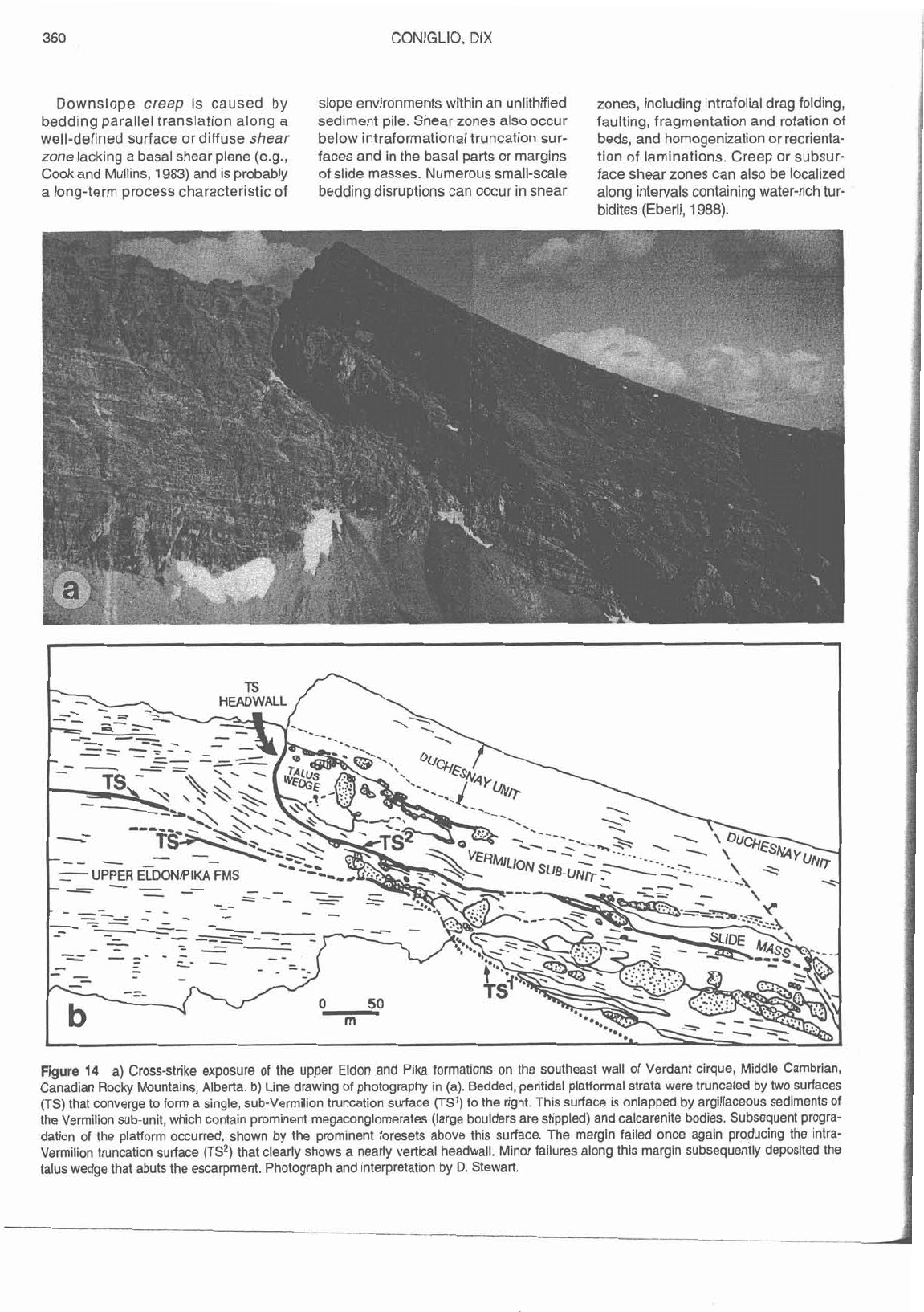
360
CONIGLIO, DIX
Downslope
creep
is caused by
slope environments within an unlithified
zones, including intrafolial drag folding,
bedding parallel translation along a
sediment pile. Shear zones also occur
faulting, fragmentation and rotation of
well-defined surface or diffuse
shear
below intraformational truncation sur-
beds, and homogenization or reorienta-
zone
lacking a basal shear plane (e.g.,
faces and in the basal parts or margins
tion of laminations. Creep or subsur-
Cook and
Mullins, 1983) and is probably
of
slide masses. Numerous small-scale
face shear zones can also be localized
a long-term process characteristic of
bedding disruptions can occur in shear
along intervals containing water-rich
tur-
bidites (Eberli, 1988).
Figure
14
a) Cross-strike exposure of the upper Eldon and Pika formations on the southeast wall of Verdant cirque, Middle Cambrian,
Canadian Rocky Mountains, Alberta. b) Line drawing of photography in (a). Bedded, peritidal platformal strata were truncated by two surfaces
(TS) that converge to form a single, sub-Vermilion truncation surface (TS') to Me right. This surface is onlapped by argillaceous sediments of
the Vermilion sub-unit, which contain prominent megaconglomerates (large boulders are stippled) and calcarenite bodies. Subsequent
progra-
dation of the platform occurred, shown by the prominent foresets above this surface. The margin failed once again producing the intra-
Vermilion truncation surface (TS2) that clearly shows a nearly vertical headwall. Minor failures along this margin subsequently deposited the
talus wedge that abuts the escarpment. Photograph and interpretation by
D.
Stewart.
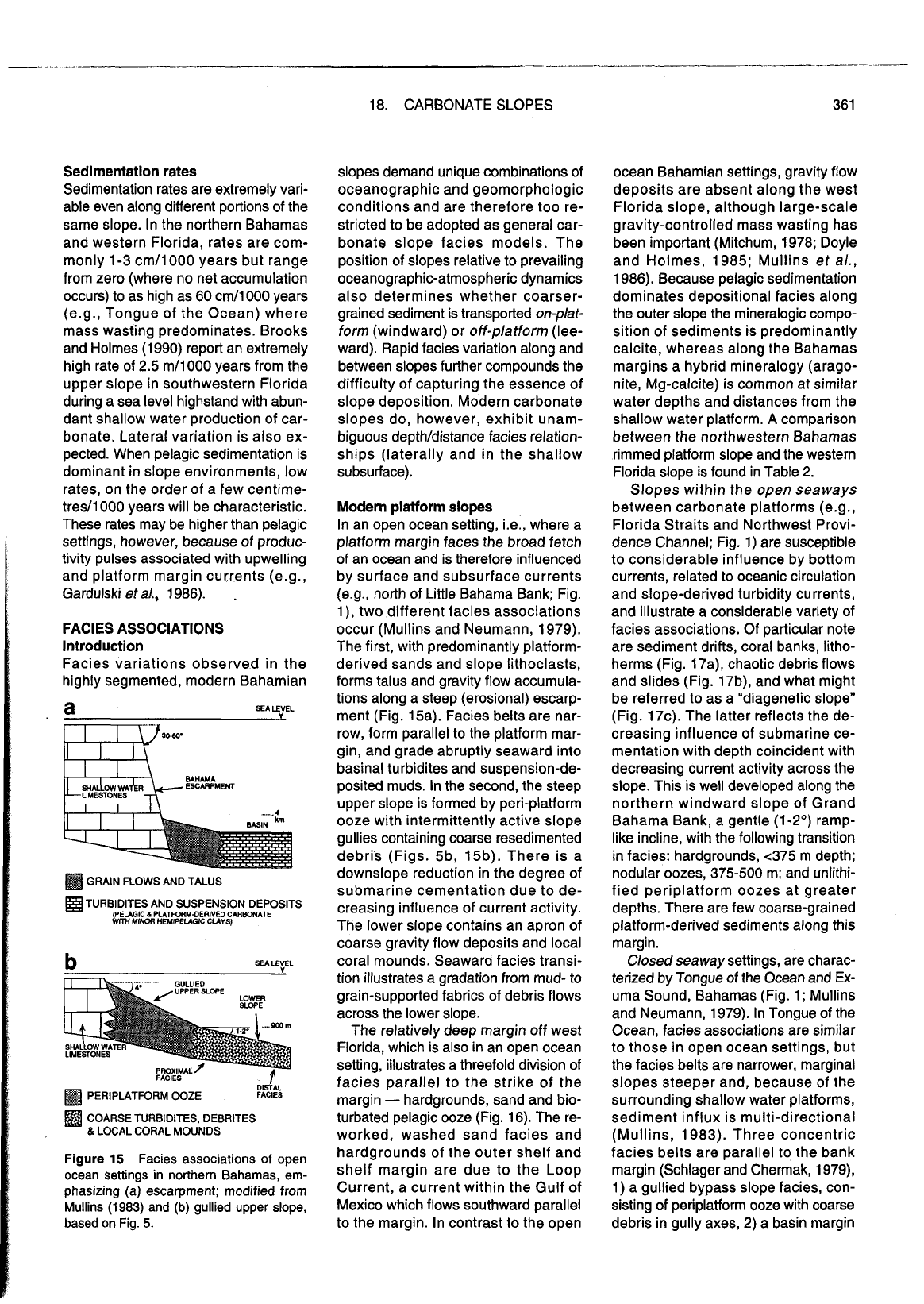
Sedimentation rates
Sedimentation rates are extremely vari-
able even along different portions of the
same slope. In the northern Bahamas
and western Florida, rates are com-
monly 1-3
cml1000 years but range
from zero (where no net accumulation
occurs) to as high as 60
cml1000 years
(e.g., Tongue of the Ocean) where
mass wasting predominates. Brooks
and
Holmes (1 990) report an extremely
high rate of 2.5
m/1000 years from the
upper slope in southwestern Florida
during a sea level highstand with abun-
dant shallow water production of car-
bonate. Lateral variation is also ex-
pected. When pelagic sedimentation is
dominant in slope environments, low
rates, on the order of a few
centime-
tres/1000 years will be characteristic.
These rates may be higher than pelagic
settings, however, because of produc-
tivity pulses associated with upwelling
and platform margin currents
(e.g.,
Gardulski et al., 1986). .
FACIES ASSOCIATIONS
Introduction
Facies variations observed in the
highly segmented, modern Bahamian
a
SEA LEVEL
cz&
LIMESTONES
I
GRAIN
FLOWS
AND
TALUS
TURBIDITES
AND
SUSPENSION
DEPOSITS
~UGIC
&
F'UlF~M.OERlVED CARBONATE
H MINOR HEMlPEUOlC CUYS)
b
SEA
LEVEL
PERIPLATFORM
OOZE
FACIES
COARSE
TURBIDITES, DEBRITES
8
LOCAL
CORAL
MOUNDS
Figure 15
Facies associations of open
ocean settings in northern Bahamas, em-
phasizing (a) escarpment; modified from
Mullins
(1983)
and
(b)
gullied upper slope,
based on Fig.
5.
18. CARBONATE SLOPES 361
slopes demand unique combinations of
oceanographic and
geomorphologic
conditions and are therefore too re-
stricted to be adopted as general car-
bonate slope facies models. The
position of slopes relative to prevailing
oceanographic-atmospheric dynamics
also determines whether
coarser-
grained sediment is transported on-plat-
form (windward) or off-platform (lee-
ward). Rapid facies variation along and
between slopes further compounds the
difficulty of capturing the essence of
slope deposition. Modern carbonate
slopes do, however, exhibit unam-
biguous depthldistance facies relation-
ships (laterally and in the shallow
subsurface).
Modern platform slopes
In an open ocean setting,
i.e., where a
platform margin faces the broad fetch
of an ocean and is therefore influenced
by surface and subsurface currents
(e.g., north of Little Bahama Bank; Fig.
I), two different facies associations
occur
(Mullins and Neumann, 1979).
The first, with predominantly
platform-
derived sands and slope lithoclasts,
forms talus and gravity flow accumula-
tions along a steep (erosional) escarp-
ment (Fig.
15a). Facies belts are nar-
row, form parallel to the platform mar-
gin, and grade abruptly seaward into
basinal turbidites and suspension-de-
posited muds. In the second, the steep
upper slope is formed by
peri-platform
ooze with intermittently active slope
gullies containing coarse resedimented
debris (Figs. 5b,
15b). There is a
downslope reduction in the degree of
submarine cementation due to de-
creasing influence of current activity.
The lower slope contains an apron of
coarse gravity flow deposits and local
coral mounds. Seaward facies transi-
tion illustrates a gradation from mud- to
grain-supported fabrics of debris flows
across the lower slope.
The relatively deep margin off west
Florida, which is also in an open ocean
setting, illustrates a threefold division of
facies parallel to the strike of the
margin
-
hardgrounds, sand and bio-
turbated pelagic ooze (Fig. 16). The re-
worked, washed sand facies and
hardgrounds of the outer shelf and
shelf margin are due to the Loop
Current, a current within the Gulf of
Mexico which flows southward parallel
to the margin. In contrast to the open
ocean Bahamian settings, gravity flow
deposits are absent along the west
Florida slope, although large-scale
gravity-controlled mass wasting has
been important (Mitchum, 1978; Doyle
and
Holmes, 1985; Mullins et
a/.,
1986). Because pelagic sedimentation
dominates depositional facies along
the outer slope the
mineralogic compo-
sition of sediments is predominantly
calcite, whereas along the Bahamas
margins a hybrid mineralogy (arago-
nite,
Mg-calcite) is common at similar
water depths and distances from the
shallow water platform.
A
comparison
between the northwestern Bahamas
rimmed platform slope and the western
Florida slope is found in Table
2.
Slopes within the open seaways
between carbonate platforms
(e.g.,
Florida Straits and Northwest Provi-
dence Channel; Fig.
I)
are susceptible
to considerable influence by bottom
currents, related to oceanic circulation
and slope-derived turbidity currents,
and illustrate a considerable variety of
facies associations. Of particular note
are sediment drifts, coral banks,
litho-
herms (Fig. 17a), chaotic debris flows
and slides (Fig.
17b), and what might
be referred to as a
"diagenetic slope"
(Fig.
17c). The latter reflects the de-
creasing influence of submarine ce-
mentation with depth coincident with
decreasing current activity across the
slope. This is well developed along the
northern windward slope of Grand
Bahama Bank, a gentle
(1-2") ramp-
like incline, with the following transition
in facies: hardgrounds,
<375 m depth;
nodular oozes, 375-500 m; and
unlithi-
fied periplatform oozes at greater
depths. There are few coarse-grained
platform-derived sediments along this
margin.
Closed seaway settings, are charac-
terized by Tongue of the Ocean and
Ex-
uma Sound, Bahamas (Fig. 1; Mullins
and Neumann, 1979). In Tongue of the
Ocean, facies associations are similar
to those in open ocean settings, but
the facies belts are narrower, marginal
slopes steeper and, because of the
surrounding shallow water platforms,
sediment influx is multi-directional
(Mullins, 1983). Three concentric
facies belts are parallel to the bank
margin
(Schlager and Chermak, 1979),
1) a gullied bypass slope facies, con-
sisting of
periplatform ooze with coarse
debris in gully axes, 2) a basin margin
